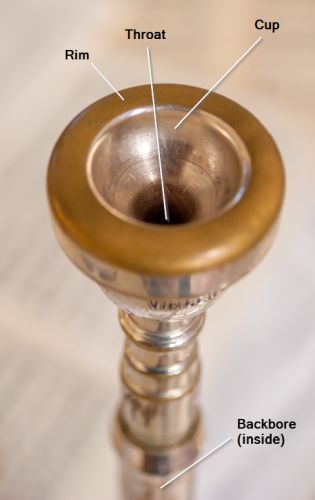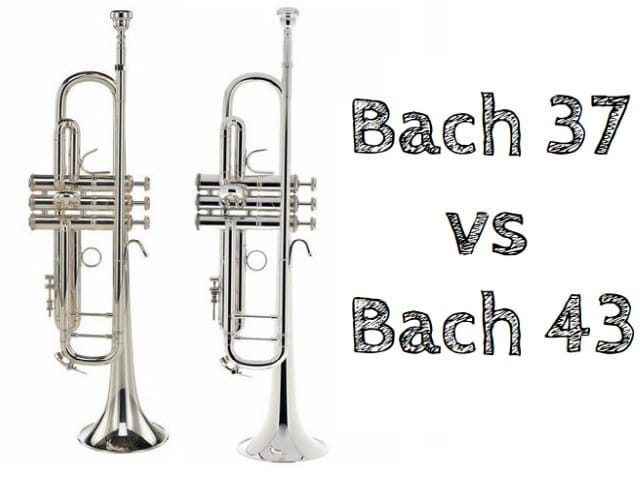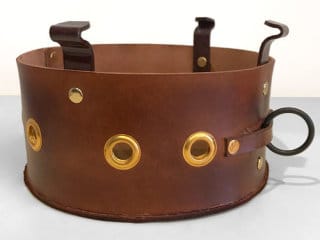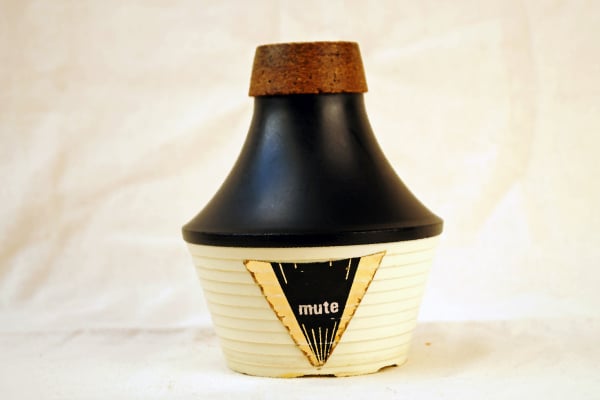Are you starting to play the trumpet and find mouthpieces altogether puzzling? Not only is there a special technique for blowing into them, but they also come with confusing numbers! You no doubt need trumpet mouthpieces explained, so we’ll answer all your questions here in our trumpet mouthpiece guide and demystify the trumpet mouthpiece for you once and for all!
What is a trumpet mouthpiece and how does it work?
The trumpet mouthpiece is the part of the trumpet that the player blows into with their mouth, hence the name ‘mouthpiece’. The function of the mouthpiece is to help facilitate the vibration that is needed to produce a sound on the trumpet.
This vibration is made by the player pressing their lips together and blowing against the mouthpiece. The mouthpiece helps to anchor and spread the lips wide which produces a better vibration and therefore a better and more consistent sound.
There are four main components to the trumpet mouthpiece: the rim, cup, throat and backbore.

The Rim
The rim of the mouthpiece is where your lips touch the mouthpiece to blow into.
The Cup
The cup of the mouthpiece is the initial chamber positioned at the rim where the vibrations resonate. The diameter of the cup determines how much vibration can be caused by the lips which can produce different sounds.
The Throat
The throat of the trumpet mouthpiece follows the cup and is the smallest chamber that the vibrations pass through in the mouthpiece. A larger throat can provide a fuller sound while a smaller throat causes a weaker sound.
The backbore
Finally, the backbore of the mouthpiece is the last chamber of the mouthpiece from which the air and vibrations move into the trumpet’s main pipe. The backbore can determine the control a player has over the sound of the instrument and also whether they want to emphasize the lower or higher notes (or even not emphasize on either).
Looking for a teacher?
Want to get lessons at the comfort of your own home? Check out the course Learn to Play the Trumpet: Beginner to Pro Made the Easy Way* on Udemy! (See their full trumpet course line-up here*!)
Does the trumpet mouthpiece make a difference?
Yes, the trumpet mouthpiece can change a lot in terms of sound, comfort and other factors. Different mouthpieces can produce different sounds depending on factors such as throat shape, cup shape and inner rim diameter. Some mouthpieces will produce brighter, higher sounds while others will produce a sound that is deeper and darker.
For example, a shallow mouthpiece cup will produce a bright sound, while a deep cup will produce a lower sound. Different mouthpieces can also affect other, non-sound related factors.
A round mouthpiece rim is generally more comfortable to the average player, while a wide rim can increase endurance while playing. A large mouthpiece cup produces a higher volume sound while increasing the sound control a player can have.
A smaller cup means that a player does not have to blow into it as hard to produce a full sound which can make it easier for newer players.
What do the trumpet mouthpiece numbers mean?
You may have heard the term ‘7C’ and ‘3C’ used to describe different trumpet mouthpieces, but what do these mean and how do they make a difference?
In the Bach system, the ‘C’ refers to the cup depth or cup volume (A is the deepest, F is the most shallow) while the number (e.g 7 or 3) refers to the aperture or rim diameter (where the smallest number has the biggest diameter). For example, the 7C has a shallower cup and smaller rim diameter compared to the 3C which has a deeper cup and larger rim diameter.
The 5C is in between the 7C and 3C in both factors, having a deeper cup and larger rim diameter than the 7C, but shallower and smaller rim diameter cup than the 3C.
There are also mouthpieces such as the 12C and 1½C. Most trumpeters use a mouthpiece that is roughly in between such as a 5C or 7C as this produces a clear, well-balanced sound. However, advanced trumpeters in orchestras may use different mouthpieces such as the 1½C.
Note
For Schilke and Yamaha mouthpieces, the system is the opposite so that a higher number on the mouthpiece indicates a bigger mouthpiece. Schilke have published a detailed guide to their mouthpiece numbers here.
How much does a trumpet mouthpiece cost?
Trumpet mouthpieces can be rather inexpensive for basic types of trumpet mouthpieces starting at $10, while at the higher end they can cost up to $100. The difference will be the build quality and can be worth it for the better sound you can get out of them.
If you’re trying to save money, you can also consider buying one or several used mouthpieces to see which one you prefer. You can find them at your local music store or at Sam Ash* online. Don’t be deterred by the thought of a second-hand mouthpiece – just make sure to clean it properly before you use it!
What is the best mouthpiece for my trumpet?
There is no definitive best mouthpiece out there as some players prefer different sounds and other factors that come with each mouthpiece. However, there is likely the best mouthpiece for you depending on your preferences.
If you like a bright sound, choose a mouthpiece with a higher number like the 7C* or 12C*. If you like a lower, deeper pitch choose the 3C* or 1½C*. You may find that some mouthpieces are also more comfortable or easier to blow into. This is why it’s good to test a wide variety so that you can find the perfect mouthpiece for you.
What is the best trumpet mouthpiece for beginners?
The 7C mouthpiece is the most common mouthpiece and widely regarded as the best trumpet mouthpiece for beginners due to how comfortable it is and its ease to produce sound. As a brand recommendation, the Bach 7C* is an excellent piece of equipment that won’t break the bank and will last you many years.
How do you remove a stuck mouthpiece?
The easiest way to remove a stuck mouthpiece without damaging your horn is with a mouthpiece puller*. These are specifically designed for the task. See our 3 methods of removing a stuck mouthpiece here.
What does a trumpet mouthpiece booster do?
A mouthpiece booster is a modification that is put over the shank of the mouthpiece. This adds extra weight to the mouthpiece which can cause a larger and more powerful sound. However, don’t expect a mouthpiece booster to enhance your playing abilities in any way.
What does a megatone mouthpiece do?
A megatone mouthpiece (or Mega Tone) weighs more than double that of a normal mouthpiece which causes a darker sound. These are usually only used by players in a performance group.
How long does it take to get used to a new trumpet mouthpiece?
This can depend a lot on the individual and their experience, preferences etc. A general rule is that the further away the number of the new mouthpiece from the original, the harder it will be to acclimate to the new mouthpiece. For example, it would likely be easier to get used to changing from a 7C to a 5C than a 7C to a 3C.
What is the best trumpet mouthpiece for high notes?
The higher the number, the higher and brighter the notes will be. For high notes, a 7C or 12C are two good mouthpieces.
What is a screamer mouthpiece?
The screamer mouthpiece is used for lead trumpets and has a shallow cup. It is known to be comfortable and provide good note accuracy.
Famous Trumpeters and their Mouthpieces
Many gearheads love knowing exactly what kind of equipment their favorite musicians use, so here’s a list for you – however, keep in mind that just because one great trumpeter produces wonderful melodies with one type of mouthpiece, the same mouthpiece might not be the best fit for you.
What kind of mouthpiece did Miles Davis use?
Miles Davis famously used a Heim 2 mouthpiece. You can see it on the cover of his album Miles & Quincy Live at Montreux*. There’s an interesting article on Trumpet Herald describing the likely confusion between Gustav, Gustat and Heim in Miles’ autobiography.
If you’re trying to get a mouthpiece like Miles’ for yourself, you can try eBay or Legends Brass for an original Heim, or look for a Kanstul Gustat, which is a perfect copy.
What mouthpiece does Wynton Marsalis use?
According to his own website, Wynton Marsalis uses a Monette PRANA B2S3 mouthpiece. I’ve seen a lot of those on eBay, although I’m not entirely sure they’re all legit. To be sure, check the list of US dealers and international dealers for Monette mouthpieces on their website to make sure you get an original.
Another confirmed mouthpiece for Wynton Marsalis (who, like Louis Armstrong, gives away his trumpet every five years and starts playing a new one) is the Bach 1¼C*.
What kind of mouthpiece did Louis Armstrong use?
Louis Armstrong used a Giardinelli mouthpiece for a while, which is now replicated in the RS Berkeley Legend Series and sometimes crops up on Amazon*.
What mouthpiece did Chet Baker use?
While Chet Baker apparently used many different types of trumpets (see this enlightening discussion on Trumpet Herald), but in terms of mouthpieces, he preferred a Bach 6B* and later a Bach 6C*.
TrumpetHub.com is a participant of the Amazon Services LLC Associates Program, an affiliate advertising program. Links marked with an asterisk (*) are affiliate links. If you buy a product through an affiliate link, we will get a small commission without extra cost to you. This helps us earn an income off the free content we provide to you. Thank you for your support!








